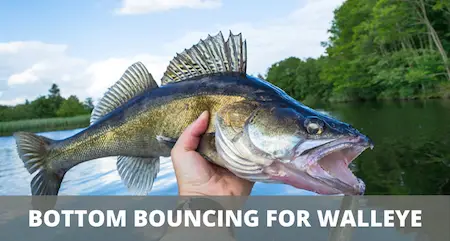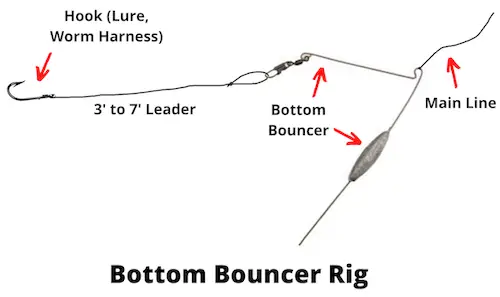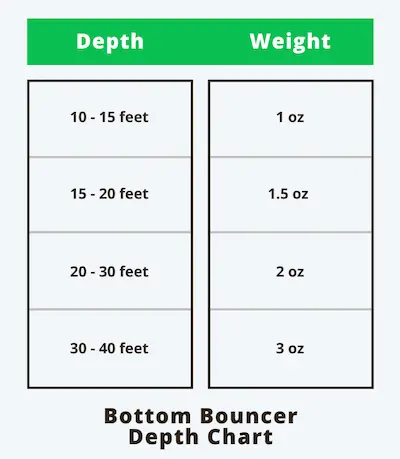Bottom Bouncer Rig For Walleye (Everything You Need To Know)
UPDATED 03 NOVEMBER 2023
by Robert Ceran
A bottom bouncer rig for walleye is one of the most effective tools for catching walleye with trolling, and it can also be very effective when used from shore.
Bottom bouncing for walleye has two key advantages compared to other tactics:
- Firstly, it keeps your bait close to the bottom at all times (which is where walleye are most often found).
- Secondly, it is designed to minimize the chances of getting snagged on cover.
Due to these key advantages, you can use bottom bouncers for walleye to cover a lot of ground while presenting your bait at exactly the right depth to entice walleye to bite.

And this makes it one of the deadliest rigs to put large numbers of walleye in your boat during the open water season.
Now let’s look at the details of how you can use a bottom bouncer rig to catch walleye.
What is a bottom bouncer?

A bottom bouncer is an L-shaped wire that has an oval weight in the middle of its long arm, and a snap swivel at the end of the short arm.
You tie your main line to the notch in the corner of the L-shaped wire, and then attach your leader to the snap swivel.
How does a bottom bouncer work?
A bottom bouncing rig for walleye helps to keep your bait close to the bottom while trolling, while minimizing the chances of getting snagged on rocks or other cover (due to the wire sticking downwards from the rig).
But in order for this rig to work properly, you need to use the right size weight relative to the depth you’re fishing at.
And you also need to troll at the optimal speed in order for the bottom bouncer to make regular contact with the bottom of the lake, but without getting snagged (refer to our chart below to choose the correct size).
Bottom bouncer setup
Now let’s talk about how to rig a bottom bouncer for walleye. The first step is to tie your main line to the notch in the corner of the L shaped wire of the bottom bouncer.
You can use either monofilament or braid as your main line, and choose a size that’s slightly stronger than your leader (I like to use 12 lb test for the main line).
Next, attach your leader to the snap swivel of the bouncer. The leader should be 3 to 7 feet long, and you should use 8 to 10 lb test fluorocarbon for this.
You can then attach a wide variety of rigs or lures at the end of your leader, or just a single hook baited with a live minnow or leech.
By far the most popular way to use a bottom bouncer rig for walleye is with a crawler harness (also known as a spinner rig). For more details on this rig, check out our guide on rigging for walleye.
But you can also use crankbaits or stickbaits with a bottom bouncer, and this approach is becoming increasingly more popular, and tends to produce bigger fish than a worm harness.
How to use a bottom bouncer
In most cases, bottom bouncer fishing is done by trolling the rig from a boat, although it’s also possible to cast a bottom bouncer from shore.
However bottom bouncing for walleye from shore is not quite as effective, as it’s hard to cover as much water as you can with trolling.
Another great thing about bottom bouncers for walleye is that they can be used with live bait presentations (for example with a nightcrawler or leech).
Again, this is much harder to achieve when casting from shore, as the live bait will tend to get torn off the hook during the casting process.
So, all in all it’s better to use a trolling tactic with this setup in order to get the most out of it. Let’s take a closer look at how to to that in the next section.
Trolling for walleye with bottom bouncers
Bottom bouncer rigs were originally designed for tolling, and this is definitely the most effective way to use them.
When used properly for trolling, they tend to outperform most other walleye rigs, and can put more than a dozen fish in your boat on a good day.
Bottom bouncer trolling speed
The best trolling speed for walleye bottom bouncers is 1 to 1.4 mph. This slow speed is necessary to make sure your bouncer maintains regular bottom contact.
If you troll faster than 1.4 mph, the whole rig tends to be pulled up in the water, and your bait will be trolled too high in the water column.
The only exception to this is if you know the walleye are suspended, in which case you can increase the speed.
On the other hand, you also don’t want to troll too slow, as this will result in the bouncer being dragged along the bottom, which increases the chances of getting your hook or lure snagged on cover.
The ideal speed allows the rig to make regular contact with the bottom, but not all the time.
Bottom bouncer depth chart

The chart above shows the different weight sizes required for a bottom bouncer to reach different depths of water.
The values given here are for 12 lb test monofilament trolled at 1.2 mph (keep in mind that different line diameters and different trolling speeds will give different results).
When choosing the right size bottom bouncer for walleye, a good rule of thumb is to use about one ounce of weight for every 10 feet of water depth.
So for 10 feet of water you would choose a 1 oz weight, and for 25 feet of water you would choose a 2 oz weight, and so on.
Can you use planer boards with bottom bouncers?
Yes, you can use planer boards for trolling with bottom bouncers.
But keep in mind that if you’re using a crawler harness, you may end up losing some fish if the walleye bite is timid, since you can’t reel in the line fast enough to react to these bites.
In that case it’s better to use a flat line trolling setup, since that allows you to react faster when you detect a bite.
If you’re trolling higher in the water column (for suspended walleye), you can increase the hook up rate on a crawler harness by exchanging the single hook at the end of the harness with a treble hook, and this setup is also better for improving the hook up rate with planer boards.
Trolling crankbaits with bottom bouncers
Bottom bouncers are great for trolling crankbaits, since they enable you to get your crankbait down to the right depth quickly.
Using a bottom bouncer allows you to troll your crankbait at less than 100 feet behind your boat, which is essential for precision trolling along the edges of rock piles and other underwater structures.
You’ll be able to target specific locations and depths, and follow contour lines with high precision, resulting in more bites.
If you were to use lead core line instead, you would need to troll your crankbait 150 feet behind your boat in order to get it down to the right depth.
That’s not very convenient for fishing along smaller underwater structures such as rock piles, points or saddles, making it very hard to target specific locations.
If you’re interested to learn about another great rig that you can use with a bottom bouncer, check out our article on how to use a slow death rig with bottom bouncer.
Can you use bottom bouncers from shore?
Yes, you can fish bottom bouncers from shore, by casting them out and retrieving them with a spinning rod setup.
Just keep in mind that you need to use a shorter leader when you do this (less than 3 feet long), as long leaders are harder to cast, and tend to get tangled with your main line during the casting process.
The best rod length to use for this is at least 7’6” or longer, as a longer rod helps to increase casting distance, and allows you to cover more ground from shore.
